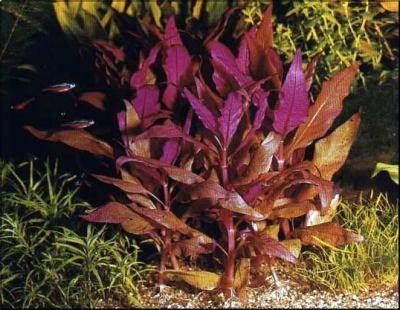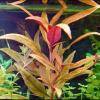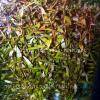Alternanthera rosaefolia
Scientific name: Alternanthera rosaefolia
Family: Amaranthaceae
Maximum size reached under cultivation: 30 - 50 cm (11.81 - 19.69 inch)
014
Recommended pH range: 5.8 - 7.2
Recommended water hardness: 4 - 12°dGH (71.43 - 214.29ppm)
0°C 32°F30°C 86°F
Recommended temperature range: 18 - 20 °C (64.4 - 68°F)
Preferred propagation method: Cuttings
Native to: South America
Growth rate: Slow
Recommended substrate: Fine gravel
Lighting requirements: Bright
Ideal placement in tank: Background
Common Names
Magenta Water Hedge
🌍 Origin
Alternanthera rosaefolia originates from South America, thriving in the tropical Amazon Basin where it grows along flooded riverbanks and in humid wetlands. It adapts well to both submerged and emersed conditions, making it a flexible and widely appreciated plant for aquariums and paludariums.
🔎 Quick Overview
- 🌊 Ideal For: Aquariums, paludariums
- 🧑🌾 Difficulty Level: Medium
- 💨 CO2 Requirements: Helpful, especially in high light, but not strictly necessary
🌱 Growing Conditions
Alternanthera rosaefolia thrives when fully submerged in aquariums, but often displays its best coloration when grown emersed in humid paludarium environments. In such setups, stems become stronger and leaf pigmentation deepens. This plant is slow-growing and highly dependent on intense lighting to prevent leaf drop and fading colors.
Use a nutrient-rich substrate, such as fine gravel or sand, and supplement regularly with iron and potassium. This promotes vivid reds and ensures compact growth. It prefers water with a pH of 5.8–7.2 and moderate hardness (4–12 dGH). CO2 injection is not mandatory, but it can significantly boost growth and intensify pigmentation, especially under bright lighting.
🏞️ Planting Area
With a height reaching up to 50 cm (19.69 inches), this plant is ideal for the background of large aquariums or as a midground focal point in smaller tanks. Plant it in small groups along the back or sides for a dense, bushy appearance. Ensure enough space between stems for light and water circulation to reach lower leaves.
🔁 Propagation
Propagation is simple via stem cuttings. Trim a healthy stem just above a node and replant it into the substrate. Each cutting should include several leaves. Frequent pruning encourages bushier growth and improves shape. Adding root tabs or planting in nutrient-rich soil will help new cuttings establish quickly and maintain the parent plant’s health.
🧪 Difficulty
Alternanthera rosaefolia is moderately challenging and recommended for aquarists with some experience. Bright lighting, regular nutrient dosing, and stable water parameters are the key requirements for success. Without these, growth slows and its vivid red coloration diminishes.
🌿 Short Description
This stunning plant is known for its magenta to deep red leaves and purplish stems that stand out in aquascapes. It’s a favorite in Dutch-style and nature-style aquariums, where color layering and contrast are essential. Its versatility allows it to grow submerged or emersed, though submerged conditions yield the most vibrant appearance. Patience is required due to its slow growth, but the result is a visually striking addition to any setup.
💡 Lighting Requirements
High-intensity light is critical. Use fluorescent lighting of 0.5–1 watt per liter (2–4 W/gal) or LED lighting of 30–40 lumens per liter (120–160 lumens/gal). Provide 8–10 hours of consistent light daily. In high-light tanks, CO2 supplementation improves foliage density and prevents lower leaf loss.
⚠️ Potential Issues
- 🟡 Yellow or Brown Leaves: Often a sign of low iron or potassium levels or poor lighting. Adjust nutrient levels and improve light intensity.
- 🐌 Poor Growth: Usually caused by inadequate fertilization or unstable water parameters. Maintain consistent care and water quality.
- 🍂 Leaf Drop: Typically occurs in shaded or low-light environments. Increase brightness and ensure adequate CO2 where possible.
🌟 Overall Appeal
Alternanthera rosaefolia is an eye-catching plant that adds color, contrast, and texture to planted aquariums and paludariums. It flourishes under proper conditions and stands out with its deep red and magenta tones. Although its care demands attention to light and nutrients, the visual rewards are well worth the effort, making it a top pick for hobbyists seeking to elevate their aquascaping game.

 Alternanthera reineckii
Alternanthera reineckii Telanthera lilacina
Telanthera lilacina